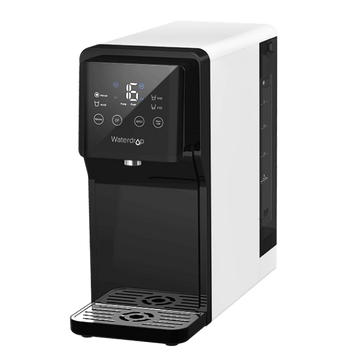Countertop RO Systems
Compact, space-saving design with 99.9% UV sterilization. Enjoy hot and cold water, no installation required. Perfect for any space!




A Series

K Series

CoreRO Series
Filter
Product Type
Filtration Type
Dispensing Option
Certification
Remineralization
Apply Filter
Clear All
Gift with Purchase
Membership Reward (i.e. x3 Reward)
Filters
39 Products
Gift with Purchase
Membership Reward (i.e. x3 Reward)
$90 Off
New
Waterdrop Reverse Osmosis Hot Cold Water Dispenser, A2
$409.00
$499.00
Sale Code: A2


Hot and Cold water
Smart touch screen TDS & filter life at a glance 3:1 Pure to Drain Save...
Best Seller
NSF Certified SGS Tested Adcanced RO Filtration Reduces PFAS View the report 6-stage Deep Filtration...
$100 Off
New
Waterdrop M1 Instant Hot RO Countertop Water Dispenser
$279.00
$379.00
Sale Code: M1


Instant Hot Water
6-Stage Filtration for Hot Water Reduces Lead, Chlorine, Chloroform, Fluoride, TDS, PFAS, Chromium-6, Copper, and...
$50 Off
Affordable
Waterdrop CoreRO Systems Launch Worry-Free Trial | Up to 20% Off Your First Countertop RO...
$70 Off
Waterdrop C1H Instant Hot Water Reverse Osmosis System
$229.00
$299.00
Sale Code: C1H


Instant Hot Water
Waterdrop CoreRO Systems Launch Worry-Free Trial | Up to 20% Off Your First Countertop RO...
$40 Off
New
Waterdrop Remineralization Countertop CoreRO System C1SL
$229.00
$269.00
Sale Code: C1SL


Alkaline Minerals
$70 Off
Affordable
Countertop Reverse Osmosis Water Filter System - Waterdrop K19
$239.00
$309.00
Sale Code: K19S


Ambient Water
Model WD-K19-S Installation Not required Pure to Drain Rate 3 : 1 Front Panel Display...
$80 Off
Model number WD-K19 Pure to Drain Rte 3:1 Daily Production Rate 75 GPD Feed Water...
Premium
Model number K19-SFK Certification NSF/ANSI 53 & 58 & 42 Pure to drain 3:1 Size(L*W*H)...
$80 Off
Countertop Reverse Osmosis Water Dispenser - Waterdrop N1
$219.00
$299.00
Sale Code: N1


Ambient Water
Model WD-N1-W System size 17.2” Product dimensions 17.1 x 7.0 x 17.8 inches Feed water...
Improves Taste and Quality This filter is made with 100% all-natural coconut shell activated carbon,...
RO Filtration The high-quality RO membrane is a core element of this filter. It effectively...
1 -12 of 39 products

Reward
Waterdrop Rewards
Earn points for every dollar you spend, and enjoy free shipping on all orders, and more.
How does a reverse osmosis water filter work?
Reverse osmosis (RO) water filters purify water by pressuring it through a semi-permeable membrane, reducing contaminants while allowing clean water
to pass. At first, the source water undergoes pre-filtration to remove sediments and chlorine. Secondly, pressurization forces it through the reverse
osmosis membrane, separating clean water from contaminants. The purified water is collected in this way. The RO filter removes salts, minerals,
bacteria, and viruses, producing safe and healthy drinking water.
What contaminants does a reverse osmosis system remove?
Reverse osmosis (RO) can effectively remove various contaminants including "forever chemicals"
PFAS, dissolved salts like sodium, chloride, and fluoride, heavy metals, as well as harmful chemicals.
What's more,
Waterdrop RO systems
can eliminate industrial pollutants, providing you and your family with safe and clean drinking water. Common impurities like sediment and foul odors
are also filtered out by our RO water filters.
Do countertop RO systems produce wastewater?
Yes, countertop reverse osmosis systems do produce wastewater just like the
undersink RO filters. During the reverse osmosis filtration process, only a portion of the water passing through the membrane becomes purified water and suitable for
consumption. The rest water which contains the blocked contaminants, is discharged as wastewater.
Is reverse osmosis water healthy?
RO systems can remove nearly 99% of particles and dissolved contaminants from the source water. Some people hold the opinion that the reverse osmosis
system removes all the minerals from the tap water, which are beneficial for the human body. If you are worried about that, investing in a
remineralization water filter
can be a good choice. The remineralization filter will re-add the essential minerals back to the filtered water.
What is the pure-to-drain ratio of the countertop reverse osmosis water filter?
It depends on different product models. If a countertop RO system has a ratio of 1:3, it means that for every 1 gallon of filtered water, about 3
gallons of wastewater is produced. Waterdrop adopts advanced technology to help you save your water bills. The X Series RO systems have a
pure-to-drain ratio of 3:1.
Why should you be concerned about forever chemicals PFAS?
In 2024,
EPA
imposed the first national limits on forever chemicals in drinking water. Detectable levels of PFAS have been identified in human tissues and breast
milk, indicating widespread exposure. High PFAS exposure is associated with adverse health effects on the endocrine system, liver, thyroid,
metabolism, development, and immunotoxicity.
Exposure to PFAS primarily occurs through drinking water, food, PFAS-containing consumer products, and dust. Notably, PFAS, especially longer-chain
variants like PFOA and PFOS, tend to bioaccumulate, binding to tissues and persisting for 2 to 9 years. A countertop reverse osmosis filter or an
undersink RO system
can filter out these chemicals from your drinking water effectively.
Ordenar por
- Características
- Más vendidos
- Alfabéticamente, A-Z
- Alfabéticamente, Z-A
- Precio, menor a mayor
- Precio, mayor a menor
- Fecha: antiguo(a) a reciente
- Fecha: reciente a antiguo(a)




































































































